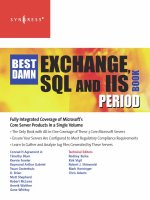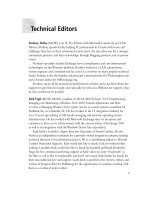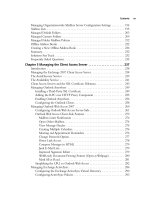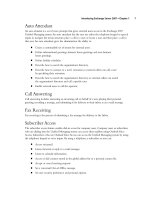Exxhange SQL And IIS- P11 pptx
Bạn đang xem bản rút gọn của tài liệu. Xem và tải ngay bản đầy đủ của tài liệu tại đây (239.28 KB, 5 trang )
Introducing Exchange Server 2007 • Chapter 1 17
Table 1.1 Continued
Service Description
Microsoft Exchange The Microsoft Exchange Information Store service
Information Store manages the Microsoft Exchange Information Store.
This includes mailbox stores and public folder stores.
If this service is stopped, mailbox stores and public folder
stores on this computer are unavailable. If this service
is disabled, any services that explicitly depend on it
will not start.
Microsoft Exchange This service performs background processing of mailboxes
Mailbox Assistants in the Exchange store.
Microsoft Exchange This service submits messages from the Mailbox server to
Mail Submission the Hub Transport Servers.
Service
Microsoft Exchange Microsoft Exchange Monitoring enables applications to
Monitoring call the Exchange diagnostic cmdlets.
Microsoft Exchange This service provides POP3 services to clients. If this service
POP3 is stopped, clients cannot connect to this computer
using the POP3 protocol.
Microsoft Exchange The Microsoft Exchange Replication Service provides
Replication Service replication functionality used by Local Continuous
Backup (Replication) and CCR.
Microsoft Exchange Microsoft Exchange Search Indexer drives indexing of
Search Indexer mailbox content. This improves the performance of the
content search.
Microsoft Exchange Microsoft Exchange Service Host provides a host for
Service Host several Microsoft Exchange services.
Microsoft Exchange Microsoft Exchange Speech Engine provides speech
Speech Engine processing services for Microsoft Exchange. If this
service is stopped, speech recognition services will
not be available to Unifi ed Messaging clients.
Microsoft Exchange Microsoft Exchange System Attendant provides
System Attendant monitoring, maintenance, and Active Directory lookup
services (e.g., monitoring of services and connectors,
defragmenting the Exchange Store, and forwarding
the Active Directory lookups to a global catalog server).
If this service is stopped, monitoring, maintenance,
and lookup services are unavailable. If this service is
disabled, any services that explicitly depend on
it will not start.
Microsoft Exchange This service provides remote search capability for
Transport Log Search Microsoft Exchange Transport log fi les.
Continued
18 Chapter 1 • Introducing Exchange Server 2007
Exchange Server Permissions
In previous versions of Exchange, administrative groups were administrative boundaries that
contained servers and other objects. Although these administrative groups could be used to segregate
administration within your organization, they were far from fl exible and thus have been discontinued
in Exchange Server 2007. Instead, you can now delegate permissions from the organization down
to the server. No matter whether your organization uses a centralized or decentralized administrative
model, you can delegate permissions to more closely match that model and easily adapt to new
models as your organization changes.
All permissions in an Exchange Server 2007 organization are confi gured by assigning
administrative access roles to Active Directory users or groups. As can be seen in Figure 1.7,
four different Exchange administrator roles exist in Exchange Server 2007.
The following is a brief description of each role:
Exchange Organization Administrators Group
The Exchange Organization Administrators Group role provides administrators with full access to all
Exchange properties and objects in the Exchange organization.
Exchange Recipient Administrators Group
The Exchange Recipient Administrators Group role has permissions to modify any Exchange
property on an Active Directory user, contact, group, dynamic distribution list, or public folder object.
Exchange Server Administrators
The Exchange Server Administrators role has access to only local server Exchange confi guration
data, either in the Active Directory or on the physical computer on which Exchange Server 2007
Table 1.1 Continued
Service Description
Microsoft Exchange This service provides the SMTP to Exchange 2007
Transport Service transport servers.
Microsoft Exchange This service enables Microsoft Exchange Unifi ed
Unifi ed Messaging Messaging features. This enables voice and fax messages
to be stored in Microsoft Exchange and gives users
telephone access to e-mail, voicemail, calendar, contacts,
or an automated attendant. If this service is stopped,
users will not be able use the Unifi ed Messaging features.
Microsoft Search Microsoft Search (Exchange) quickly creates full-text
(Exchange) indexes on content and properties of structured data to
enable fast linguistic searches on this data.
Introducing Exchange Server 2007 • Chapter 1 19
is installed. Users who are members of the Exchange Server Administrators role have permission to
administer a particular server, but do not have permission to perform operations that have global
impact in the Exchange organization.
Exchange View-Only Administrators Group
The Exchange View-Only Administrators Group role has read-only access to the entire Exchange
organization tree in the Active Directory confi guration container, and read-only access to all of the
Windows domain containers that have Exchange recipients.
Figure 1.7 Adding an Exchange Administrator to an Administrator Role
20 Chapter 1 • Introducing Exchange Server 2007
64-Bit Support Only
One of the major architectural changes in the Exchange Server 2007 product is the shift to a true
64-bit environment. As you might be aware, previous versions of Exchange did support 64-bit
processors, however they didn’t take advantage of them since they were still only 32-bit applications
under the hood. Exchange Server 2007 is a true 64-bit messaging platform, and thus gives signifi cant
database scalability creating larger mailbox and/or public folder stores in your environment. This is
possible due to the fact that 64-bit processing allows you to store much more data in memory,
causing a lot less I/O load on the disks.
In addition, there is support for much larger mailboxes (+2GB). The move to 64-bit also means
you are no longer limited to the 4 GB memory limitation of Exchange 2003 in your servers.
Exchange 2007 supports up to eight TB of memory, but at the time of this writing, the hardware
limit is 64 GB of RAM, which should be suffi cient.
The 64-bit Support Only heading is not 100 percent true, since a 32-bit version actually exists;
however it is meant for evaluation and testing purposes only. The 32-bit version is a time bombed
version in addition to not being supported in a production. There’s only one exception to this rule,
and that is using the 32-bit versions to install the Management Console and perform management
tasks (using the EMC and Shell, extending the Active Directory and Schema with Setup, and so forth.)
Active Directory-Based
Routing Topology
With Exchange Server 2007, the way messages are routed between the Hub Transport servers (known
as Bridgehead servers in Exchange Server 2003) has changed considerably. You no longer need to set up
routing group connectors between routing groups in the Exchange organization when you design your
Exchange topology. The routing group functionality has been removed from the Exchange product
(see the list of discontinued features later in this chapter). Why has this fl exible way of routing messages
throughout an Exchange organization been removed? It has been determined that routing groups actually
have several drawbacks, one being long stretches of time where two servers disagree about a connection
state, in many situations causing routing loops. Another is the diffi culty in tracking why a message took
a given route at a given point in time, because the link state table for the Exchange topology was never
persistent and /or logged. Lastly, the routing groups and routing group connector concept forced Exchange
administrators to recreate and mimic the underlying network, which can be a time-consuming task.
So, how do you set up your routing topology in Exchange Server 2007? You don’t! Exchange
Server 2007 is a site-aware application, meaning that it can determine its own Active Directory
site membership and the Active Directory site membership of other servers by querying Active
Directory. Instead of using its own routing group topology, Exchange uses the AD directory service
site topology to determine how messages are transported in the organization. This means that the
Hub Transport servers in your Exchange organization retrieve information from Active Directory
in order to determine how messages should be routed between servers. You need to deploy a Hub
Transport server in each site containing a Mailbox server, meaning when user A in one site sends
a message to user B in another site, the Mailbox server contacts the Hub Transport server in its own
site, and then routes the message to the Hub Transport server in user B’s site, ultimately delivering the
message to the mailbox server hosting user B’s mailbox.
Introducing Exchange Server 2007 • Chapter 1 21
De-emphasized Features
The following legacy Exchange features have been de-emphasized in Exchange Server 2007. What
does that mean? It means that these features are still included in the Exchange product, but they’re
not prioritized anymore, and will most likely disappear in the next Exchange release after Exchange
Server 2007 (currently codenamed E14).
■
Public Folders
■
Proxy Address Generators
■
CDO 1.21
■
MAPI32
■
CDOEX (CDO 3.0)
■
Exchange WebDAV extensions
■
ExOLEDB
■
Store Events
■
Streaming backup APIs
■
Exchange Server Virus Scanning API (VSAPI)
Discontinued Features
Because of the major architectural changes in Exchange Server 2007, several of the features and
components included in previous versions of Exchange have been discontinued in Exchange Server
2007. Discontinued features are features that for some reason or other didn’t make it into Exchange
Server 2007, either because they were replaced by other new features or because the Exchange
Product team no longer thought it made sense to keep supporting them in Exchange Server 2007.
Below is a comprehensive list of features that didn’t make it into Exchange Server 2007.
Architecture Features
Several architectural related features were removed or replaced in Exchange Server 2007.
■
Routing Groups
■
Administrative Groups
■
Link State Routing
■
Routing Objects
■
IMF (replaced by Content Filter which can be considered IMF v3)
■
Network Attached Storage (NAS)
■
Exchange installable File System (ExIFS)
■
Event Service









